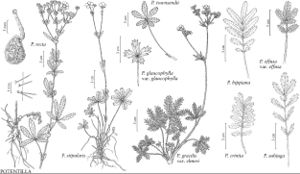Potentilla recta
Sp. Pl. 1: 497. 1753.
Cauline leaves: petiole (3–)4–8 cm, long hairs common, 2–4 mm, short hairs common to abundant; leaflets 5–7, 1.5–10 × 0.5–3.5 cm, long hairs common, 0.5–2 mm abaxially, 1 mm and stiffly appressed adaxially, short hairs common on primary veins abaxially, glands sparse to common abaxially. Flowers: epicalyx bractlets narrowly lanceolate to lanceolate, 5–12 × 1–2 mm; sepals 4–10(–12) mm, apex acute to acuminate; petals (4–)7–10(–13) × 7–10 mm; filaments 0.5–2.8 mm, anthers 0.8–1.2 mm; carpels 80–140. Achenes 1.2–1.8 mm. 2n = 28, 42 (Eurasia).
Phenology: Flowering late spring–summer.
Habitat: Roadsides, waste places, fields, grasslands, shrublands, forests
Elevation: 0–2100 m
Distribution

Introduced; Alta., B.C., Man., N.B., Nfld. and Labr. (Nfld.), N.S., Ont., P.E.I., Que., Sask., Ala., Alaska, Ariz., Ark., Calif., Colo., Conn., Del., D.C., Fla., Ga., Idaho, Ill., Ind., Iowa, Kans., Ky., La., Maine, Md., Mass., Mich., Minn., Miss., Mo., Mont., Nebr., Nev., N.H., N.J., N.Mex., N.Y., N.C., N.Dak., Ohio, Okla., Oreg., Pa., R.I., S.C., S.Dak., Tenn., Tex., Utah, Vt., Va., Wash., W.Va., Wis., Wyo., Eurasia, n Africa, introduced also in South America (Argentina), Pacific Islands (New Zealand), Australia.
Discussion
The Potentilla recta species group is among the most complex in Europe and western Asia, with diverse taxonomic circumscriptions. The most conservative is adopted here (also used by P. W. Ball et al. 1968; J. Soják 2004), in which most variation is included in a broadly defined P. recta. An alternative is provided by A. Kurtto et al. (in J. Jalas et al. 1972+, vol. 13), who recognized six subspecies of P. recta and three additional species. The phase found in North America is rather uniform, corresponding to the pale-flowered sulphurea variant that Kurtto et al. included in subsp. recta. However, B. Boivin (1952, 1966b) accepted two additional varieties in Canada, locally naturalized in Ontario and Saskatchewan. Nomenclaturally these correspond to subsp. obscura and subsp. pilosa as recognized by Kurtto et al., but other than 5-foliate leaves in var. obscura (Boivin 1967–1979), the morphological basis for Boivin's taxonomic conclusions is unclear.
The earliest North American collection of Potentilla recta seen by the authors was gathered by C. W. Short as a weed in a garden in Montreal in 1852 (MO). It was encountered initially as a naturalized plant in New York in 1879, and by 1900 it was fairly widespread in New England before being found in Ontario, Canada. From there it spread rapidly throughout much of the northern United States and southern Canada (K. Zouhar, http://www.fs.fed.us/database/feis/). It was in British Columbia by 1914, and in a Forest Service pasture in eastern Utah by 1924. The species is listed as a noxious weed in much of North America, spreading aggressively in both natural and disturbed habitats.
The species is often confused with the native, widespread Potentilla gracilis (sect. Graciles), but differs from the latter in having ephemeral basal leaves (often replaced by a new flush in later summer), pale yellow petals, and shorter styles. The long, stiff, spreading, tubercle-based hairs on stems and petioles of P. recta, overtopping a layer of short hairs and glands, also serve to distinguish this aggressive species from native P. gracilis at any stage of the life cycle. The leaves are also sometimes mistaken for Cannabis. The name P. recta is sometimes confused with P. erecta (Linnaeus) Raeuschel, a much different plant in sect. Potentilla.
Selected References
None.
